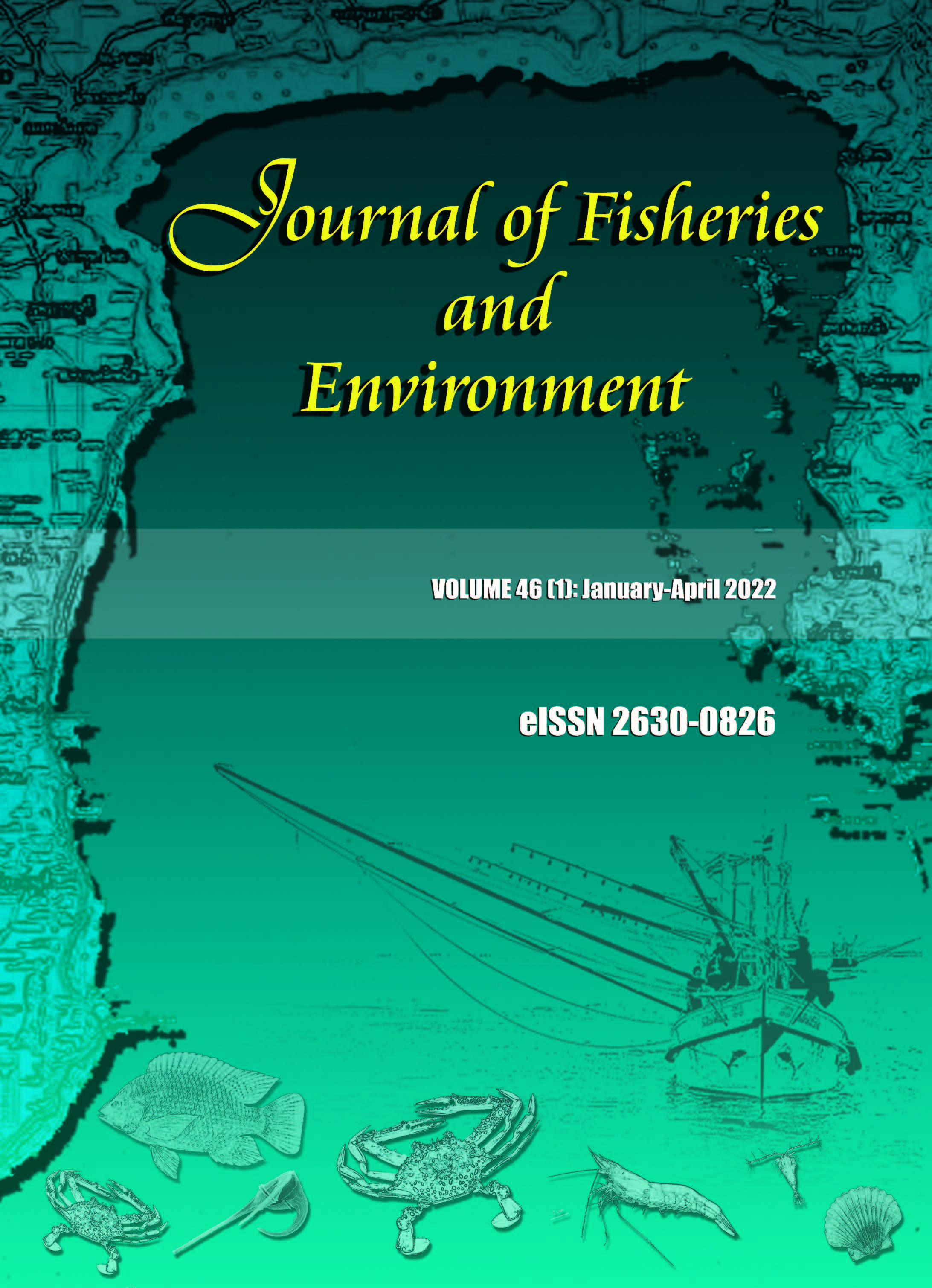Benefits of Male Monosex Culture of Giant Freshwater Prawn (Macrobrachium rosenbergii): Improving Growth Performance, Production Yield, and Profitability
Main Article Content
Abstract
We evaluated the advantages of all-male giant freshwater prawn (Macrobrachium rosenbergii) culture over traditional mixed-sex and all-female systems in the aspects of growth performance, production yield, and profitability. The prawn post-larvae were reared in a nursery pond for 43 days until the male sexual characteristics (gonopore complex) could be distinguished externally, then they were sexed and transferred to monosex grow-out ponds (two ponds per sex) and cultured for another 140 days. The prawn post-larvae in the mixed-sex group were reared for 60 days in the nursery phase and 165 days in the grow-out phase. At harvest, the male prawns from the all-male group had higher body weight (93.02 g), average daily growth (0.66 g·day-1), and specific growth rate (3.41%·day-1), compared to the males in the mixed-sex system (69.38 g, 0.41 g·day-1, and 2.56%·day-1, respectively). The proportion of an unfavorable “small male” morphotype was reduced from 20.11 % in the mixed-sex culture to 4.67 % in the all-male system, whereas that of a desirable “orange claw” morphotype was increased from 38.59 to 61.33 %. Ultimately, the production yield of the all-male group was 2,076.6 kg·ha-1, whereas that of the mixed-sex system was 1,273.8 kg·ha-1. The cost-benefit analysis revealed that the former was 155.78 % more profitable than the latter. The all-female group showed the best survival rate and feed conversion ratio, yet it was the least profitable system. In conclusion, the all-male culture was the most productive and profitable system of giant freshwater prawn farming.
Article Details

This work is licensed under a Creative Commons Attribution-NonCommercial-NoDerivatives 4.0 International License.
References
Beardmore, J.A., G.C. Mair and R.I. Lewis. 2001. Monosex male production in finfish as exemplified by tilapia: Applications, problems, and prospects. Aquaculture 197(1-4): 283-301.
Bell, T.A. and D.V. Lightner. 1988. A Handbook of Normal Penaeid Shrimp Histology. World Aquaculture Society, Baton Rouge, Louisiana, USA. 114 pp.
Brody, T., D. Cohen, A. Barnes and A. Spector. 1980. Yield characteristics of Macrobrachium rosenbergii in temperate zone aquaculture. Aquaculture 21: 375-385.
Cohen, D., Z. Ra’anan and T. Brody. 1981. Population profile development and morphotypic differentiation in the giant freshwater prawn Macrobrachium rosenbergii (de Man). Journal of World Mariculture Society 12(2): 231-243.
Dinh, H. and N.H. Nguyen. 2014. Genetic inheritance of female and male morphotypes in giant freshwater prawn Macrobrachium rosenbergii. PLoS ONE 9(2): e90142. DOI: 10.1371/journal.pone.0090142.
Food and Agriculture Organization of the United Nations (FAO). 2022. FishStatJ-Software for Fishery Statistical Time Series (version 4.01.9). (Computer Program). http://www.fao.org/fishery/statistics/software/fishstatj/en. Cited 30 Sep 2021.
Karplus, I. and A. Barki. 2019. Male morphotypes and alternative mating tactics in freshwater prawns of the genus Macrobrachium: A review. Reviews in Aquaculture 11(3): 925-940.
Kembenya, E.M. and R.N. Ondiba. 2021. Growth performance of male monosex and mixed sex Nile tilapia (Oreochromis niloticus L.) reared in cages, Lake Victoria, Kenya. International Aquatic Research 13(3): 227-232.
Levy, T., O. Rosen, B. Eilam, D. Azulay, I. Zohar and E.D. Aflalo. 2017. All female monosex culture in the freshwater prawn Macrobamchium rosenbergii - A comparative large-scale field study. Aquaculture 479: 857-862.
Limsuwan, C. and P. Chanratchakool. 2004. Shrimp Culture Industry of Thailand. National Research Council of Thailand, Bangkok, Thailand. 259 pp.
Malecha, S. 2012. The case for all-female freshwater prawn, Macrobranchium rosenbergii (De man), culture. Aquaculture Research 43: 1038-1048.
Na‐Nakorn, U. and O. Jintasataporn. 2012. Current status & prospects of farming the giant river prawn (Macrobrachium rosenbergii de Man 1879) in Thailand. Aquaculture Research 43(7): 1015-1022.
Nair, C.M., K.R. Salin, M.S. Raju and M. Sebastian. 2006. Economic analysis of monosex culture of giant freshwater prawn (Macrobrachium rosenbergii De Man): A case study. Aquaculture Research 37: 949-954.
New, M.B. 2002. Farming Freshwater Prawns: A Manual for the Culture of the Giant River Prawn (Macrobrachium rosenbergii). Food and Agriculture Organization of the United Nations, Rome, Italy. 212 pp.
New, M.B. 2022. Cultured aquatic species information programme. Macrobrachium rosenbergii (De Man 1879). http://www.fao.org/fishery/en/culturedspecies/macrobrachium_rosenbergii/en. Cited 30 Sep 2021.
Ra’anan, Z. and A. Sagi. 1985. Alternative mating strategies in male morphotypes of the freshwater prawn Macrobrachium rosenbergii (De Man). Biological Bulletin 169(3): 592-601.
Ra’anan, Z., A. Zagi, Y. Wax, I. Karplus, G. Hulata and A. Kuris. 1991. Growth, size rank, and maturation of the freshwater prawn, Macrobrachium rosenbergii: Analysis of marked prawns in an experimental population. Biological Bulletin 181(3): 379-386.
Rungsin, W., A. Swatdipong and U. Na-Nakorn. 2012. Development stages of androgenic glands in Giant river prawn, Macrobrachium rosenbergii De Man, 1879 in relation to size and age, and the success rate of feminization after andrectomy in small and large size prawn. Aquaculture 354-355: 136-143.
Rungsin, W., N. Paankhao and U. Na-Nakorn. 2006. Production of all-male stock by neofemale technology of the Thai strain of freshwater prawn, Macrobrachium rosenbergii. Aquaculture 259(1-4): 88-94.
Sagi, A., Z. Ra’anan, D. Cohen and Y. Wax. 1986. Production of Macrobrachium rosenbergii in monosex population: yield characteristic under intensive monoculture condition in cages. Aquaculture 51: 265-275.
Siddiqui, A.Q., Y.S. Al‐Hafedh, A.H. Al‐Harbi and S.A. Ali. 1997. Effects of stocking density and monosex culture of freshwater prawn Macrobrachium rosenbergii on growth and production in concrete tanks in Saudi Arabia. Journal of the world aquaculture
Tan, K., H. Jiang, D. Jiang and W. Wang. 2020. Sex reversal and the androgenic gland (AG) in Macrobrachium rosenbergii: A review. Aquaculture and Fisheries 5(6): 283-288.
Tidwell, J.H., L.R., D’Abramo, S.D., Coyle, L.A., Bright, C., Shultz, Z., Kupchinsky, P. Schwartz and C. Upstrom. 2015. Production characteristics of all-male and mixed-sex giant river prawns, Macrobrachium rosenbergii, grown in earthen ponds in Kentucky and Mississippi USA. Journal of the World Aquaculture Society 46: 139-148.


